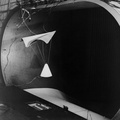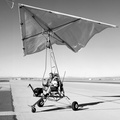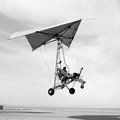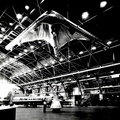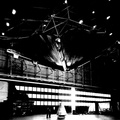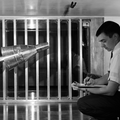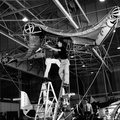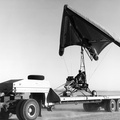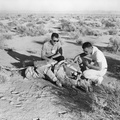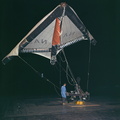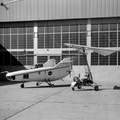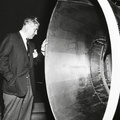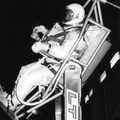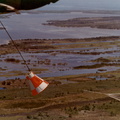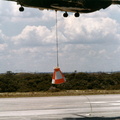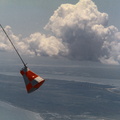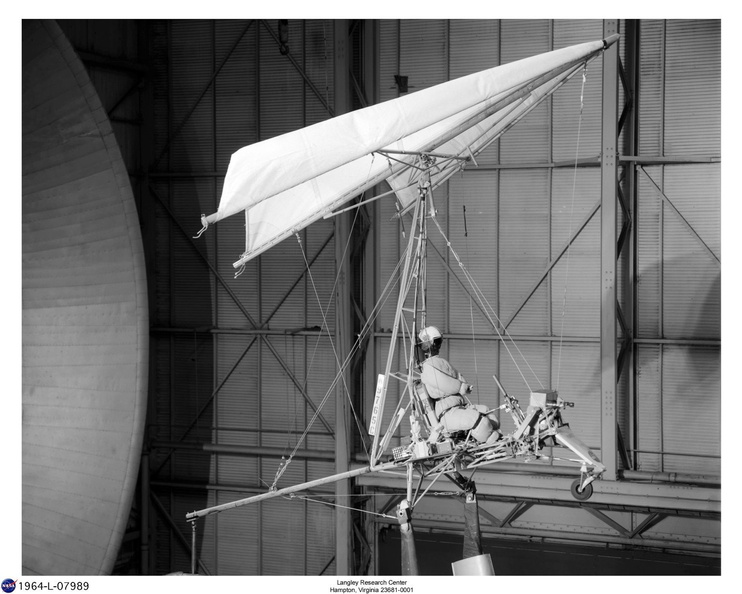
WIKIARCHIVES.SPACE
The Human Spaceflight Archive

Test of Paresev I-A Rogallo research vehicle in the Full Scale wind tunnel. Richard P. Hallion wrote: "The best way to acquire ... experience, of course, was by building and flying a Parawing. Two who actively favored such an approach were center research pilots Neil Armstrong and Milt Thompson. they approached Paul Bikle, who liked the idea, but recognized that both pilots had heavy Dyna-Soar commitments; FRC could not spare their services elsewhere, even to a project as interesting as the proposed Parawing. Instead, Bikle called in a group of center engineers under the direction of Charles Richards, a team composed of Richard Klein, Vic Horton, Gary Layton, and Joe Wilson. Bilke's instructions were characteristically short and to the point: build a single-seat Paraglider and *do it quick and cheap.' All this took place just before Christmas 1961. The team, now totaling nine engineers and technicians, set to work on this *Paraglider Research Vehicle,' conveniently abbreviated Paresev. Seven weeks later, after expending $4280 on construction and materials, the team rolled out the Paresev I. It resembled a grown-up tricycle, with a rudimentary seat, an angled tripod mast, and perched on top of the mast, a 14-square-meter Rogallo-type parawing. The vehicle weighed 272 kilograms, had a height of over 3.4 meters, and a length of 4.5 meters. The pilot sat out in the open, strapped in the seat, with no enclosure of any kind. He controlled the descent rate by tilting the wing fore and aft, and turned by tilting the wing from side to side. NASA registered the Paresev, the first NASA research airplane to be constructed totally *in-house,' with the Federal Aviation Administration on 12 February 1962. Flight testing started immediately." Published in James R. Hansen, Spaceflight Revolution: NASA Langley Research Center From Sputnik to Apollo, NASA SP-4308, pp. 380-387; Richard P. Hallion, On the Frontier: Flight Research at Dryden, 1946-1981, NASA SP-4303, pp. 138-139.
Information
- Taken in
- NASA Langley
- Author
- NASA
- Description
-
Test of Paresev I-A Rogallo research vehicle in the Full Scale wind tunnel. Richard P. Hallion wrote: "The best way to acquire ... experience, of course, was by building and flying a Parawing. Two who actively favored such an approach were center research pilots Neil Armstrong and Milt Thompson. they approached Paul Bikle, who liked the idea, but recognized that both pilots had heavy Dyna-Soar commitments; FRC could not spare their services elsewhere, even to a project as interesting as the proposed Parawing. Instead, Bikle called in a group of center engineers under the direction of Charles Richards, a team composed of Richard Klein, Vic Horton, Gary Layton, and Joe Wilson. Bilke's instructions were characteristically short and to the point: build a single-seat Paraglider and *do it quick and cheap.' All this took place just before Christmas 1961. The team, now totaling nine engineers and technicians, set to work on this *Paraglider Research Vehicle,' conveniently abbreviated Paresev. Seven weeks later, after expending $4280 on construction and materials, the team rolled out the Paresev I. It resembled a grown-up tricycle, with a rudimentary seat, an angled tripod mast, and perched on top of the mast, a 14-square-meter Rogallo-type parawing. The vehicle weighed 272 kilograms, had a height of over 3.4 meters, and a length of 4.5 meters. The pilot sat out in the open, strapped in the seat, with no enclosure of any kind. He controlled the descent rate by tilting the wing fore and aft, and turned by tilting the wing from side to side. NASA registered the Paresev, the first NASA research airplane to be constructed totally *in-house,' with the Federal Aviation Administration on 12 February 1962. Flight testing started immediately." Published in James R. Hansen, Spaceflight Revolution: NASA Langley Research Center From Sputnik to Apollo, NASA SP-4308, pp. 380-387; Richard P. Hallion, On the Frontier: Flight Research at Dryden, 1946-1981, NASA SP-4303, pp. 138-139.
- Created on
- Albums
- US SPACE PROGRAM / GEMINI / TESTS
- Source link
- https://www.dvidshub.net/search/?q=rogallo&view=grid
- Visits
- 41
Location : 37.086200, -76.380884
- Rating score
- no rate
- Rate this photo
- License
- Public Domain
- Modified by WikiArchives
- No (original)
- Downloads
- 0
Powered by Piwigo













































